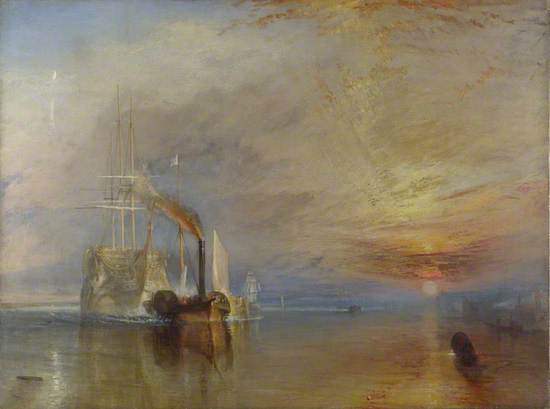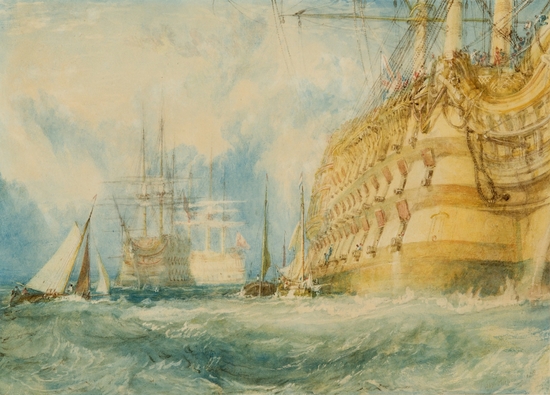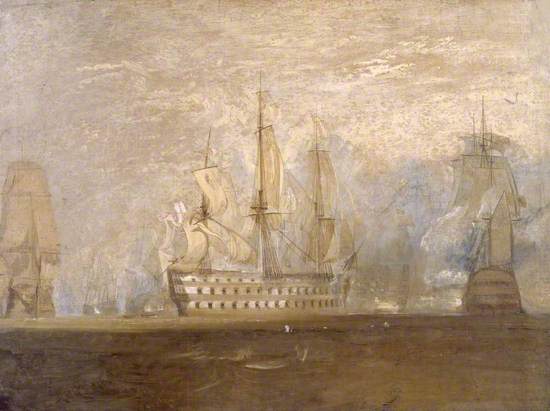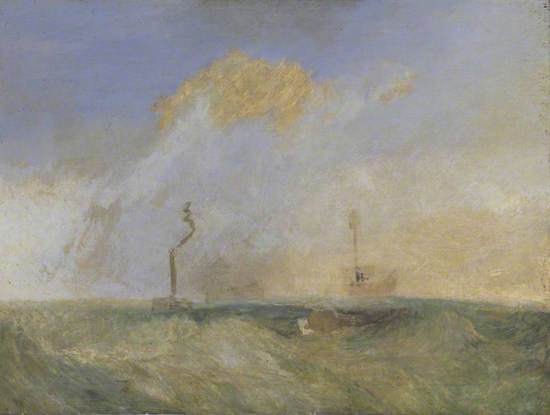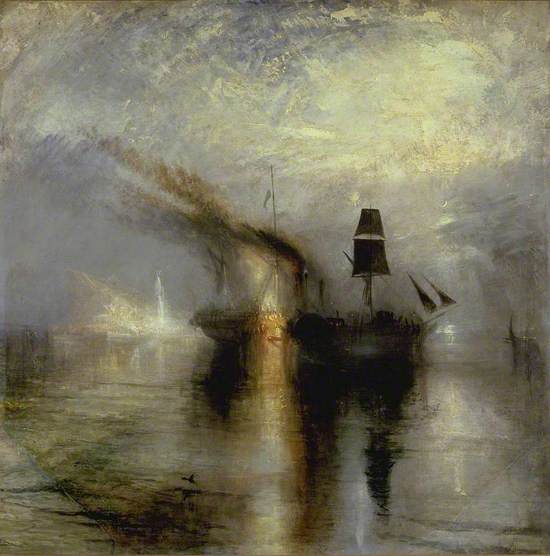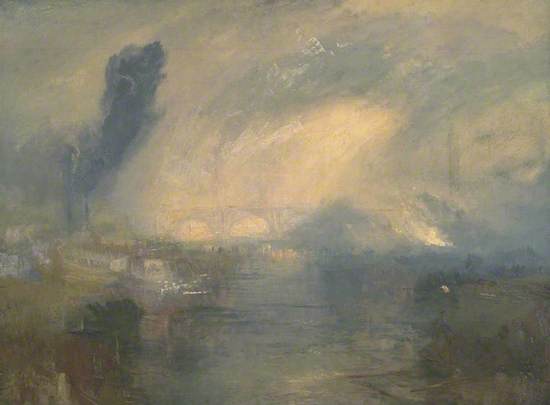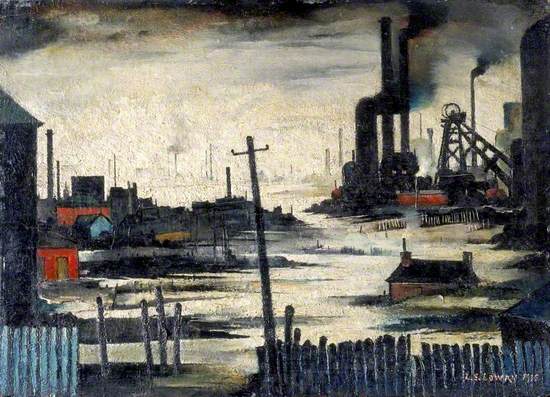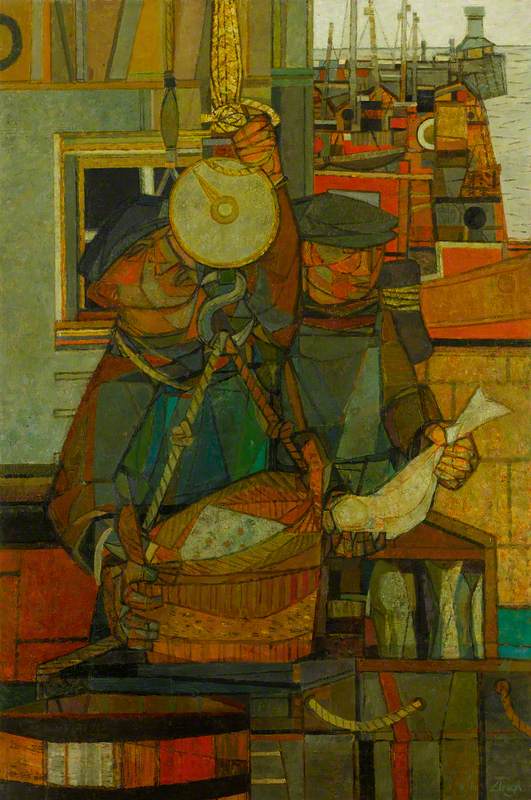Joseph Mallord William Turner (1775-1851) is one of Britain’s best-known artists. This exhibition celebrates his work and spotlights his most famous painting, The Fighting Temeraire. This ‘National Treasure’ is displayed at the Laing as part of the National Gallery’s 200th anniversary celebrations - there is more information here:
https://www.nationalgallery.org.uk/exhibitions/across-the-uk/national-treasures
https://laingartgallery.org.uk/whats-on/turner-art-industry-and-nostalgia
The exhibition at the Laing runs 10 May - 7 September 2024. It introduces Turner, contextualises The Fighting Temeraire, and considers how the painting reflects the Industrial Revolution and the northeast's role in this story.
The Fighting Temeraire tugged to her Last Berth to be broken up, 1838
Joseph Mallord William Turner (1775–1851)
Oil on canvas
H 90.7 x W 121.6 cm
The National Gallery, London
This curation showcases a small selection of works from the exhibition, which includes over 60 objects and 26 works by Turner.
The exhibition is curated by Laing Art Gallery in partnership with The National Gallery. We would like to thank The National Gallery, Barbour, the Foyle Foundation and the Friends of the Laing Art Gallery for their support, and to extend our thanks to all of the exhibition's lenders.
J.M.W. Turner: Painter of Seas, Skies & British Life
The first section of the exhibition introduces Turner as an artist and provides some background information about his life and career. It includes numerous examples of his work in the watercolour medium, revealing how he constantly found new ways to capture transient atmospheric effects on paper.
Turner travelled regularly, undertaking sketching tours each summer to gather artistic subjects. Until the Napoleonic Wars ended in 1815, these journeys were almost entirely confined to British shores, and his range of subject matter included many British landscape subjects - such as views of the Northumberland coast. From 1817, his range of landscape subjects expanded to reflect his regular tours in Europe.
.

Dunstanburgh Castle
Turner visited the north of England as a young man in 1797. This watercolour is based on a sketch made during this tour. Its Northumberland leg included Warkworth, Bamburgh and Lindisfarne as well as Dunstanburgh, just north of Craster. This dramatic view of Dunstanburgh Castle demonstrates the generally darker colour palette Turner used in his early career.
Joseph Mallord William Turner (1775-1851), Dunstanburgh Castle, about 1798, pencil and watercolour on paper. Laing Art Gallery
.

Dinant on the Meuse
Turner’s travels on the continent allowed him to expand his range of landscape subject matter. This watercolour drawing on blue paper shows the Belgian city of Dinant from the north-west. Turner based his composition on a pencil sketch made during his second tour of the rivers Meuse and Mosel in 1839. He intended the view for a ‘Rivers of Europe’ print series, but only the drawings of the Loire and the Seine were actually published. These earlier French views also include Turner’s most extensive exploration of steamboats.
Joseph Mallord William Turner (1775-1851), Dinant on the Meuse, 1839, pencil, watercolour, bodycolour and chalk on blue paper. Laing Art Gallery
The Temeraire of Trafalgar
The Temeraire was a British ‘man-of-war’ built from over 5000 British oak trees at Chatham Dockyard in Kent. The ship served in the French Revolutionary and Napoleonic Wars from 1798. It gained renown following the Battle of Trafalgar in 1805, when Newcastle-born Admiral Collingwood singled out Temeraire for praise in his report of the battle.
Sometimes considered by his contemporaries as a marine painter, Turner made many studies of warships. His depictions of Temeraire itself show the ship either in the midst of battle or about to be broken up. But these are only two notable instances in a longer history, which also included blockade duty, a mutiny, time defending British colonial interests, and time spent as a prison ship.
A First Rate Taking in Stores
According to the family of Turner’s friend and patron, Walter Fawkes of Farnley Hall, Turner made this watercolour at Farnley after being asked to draw a Royal Navy ‘ship of the line.’ The warship depicted is a ‘first rate’ ship with over 110 guns. Temeraire, by contrast, was a ‘second rate’ ship with 90-98, plus lighter guns. Turner’s watercolour emphasises the warship’s size and demonstrates the depth of his knowledge given that the drawing was an act of memory made at a moment’s notice.
Joseph Mallord William Turner (1775–1851)
Pencil & watercolour, heightened with white on paper
H 28.6 x W 39.7 cm
The Higgins Bedford
First Sketch for 'The Battle of Trafalgar'
In 1823, Turner received his only royal commission: a painting commemorating the Battle of Trafalgar. He made two oil sketches in preparation for his enormous, finished canvas, which is now in the National Maritime Museum. This first sketch focuses on the ships’ positions, with Victory, British naval commander Horatio Nelson’s flagship, front and centre. Temeraire’s position is unclear here but can be glimpsed on the right of Turner’s finished composition.
Joseph Mallord William Turner (1775–1851)
Oil on canvas
H 90.2 x W 121.3 cm
Tate
Second Sketch for 'The Battle of Trafalgar'
In his second sketch, we see how Turner has developed the scene. Rather than focusing our attention on the death of Nelson on board the Victory, Turner emphasises the drowning figures in the sea. In this way, his painting laments the horrors and loss of life faced by ordinary seamen in the battle rather than glorifying it.
Joseph Mallord William Turner (1775–1851)
Oil on canvas
H 90.2 x W 121.3 cm
Tate
Sketch for 'The Battle of Trafalgar, and the Victory of Lord Nelson over the Combined French and Spanish Fleets, October 21, 1805'
This oil sketch is by the Sunderland-born Clarkson Stanfield. He made it in preparation for his larger view of the battle for the United Services Club in Pall Mall. Stanfield had been a sailor, and painted theatre scenery before becoming one of the leading marine painters of his day (second only, perhaps, to Turner, whom he admired and was friendly with).
In the painting, Temeraire is the furthest left of the three ships in the centre. Lashed to Temeraire with a mast lying across the deck and almost central in the image is the French ship Redoubtable. From the other side, Temeraire is firing at the approaching ship, Fougueux. Victory is seen centre-right.
Clarkson Frederick Stanfield (1793–1867)
Oil on oak
H 38.7 x W 80.3 cm
Tate
Thames to Tyne: capturing the age of steam
Temeraire's final journey was along the Thames. But the tugboats towing it and their engines came from another great river, and one that was the source of most of London’s coal: the Tyne. Turner’s views of industrial Newcastle show a riverside fringed with the chimneys of its industries, which included lead, glass and salt works. The dominance of the coal industry is clear, with small keel boats working to move coal to the ships waiting in deeper water. The northeast was also a growing centre for boat and shipbuilding as the industry moved towards iron and steam power.
Turner was particularly fascinated by steamboats and steamships, which he included in major paintings such as Peace - Burial at Sea and The Fighting Temeraire.
The Fighting Temeraire tugged to her Last Berth to be broken up, 1838
The Temeraire is depicted on its final journey to be scrapped. It is towed by a steam tug along the Thames from Sheerness in Kent to Rotherhithe in south-east London. The old ship appears ghostlike and the setting sun signals the end of the heroic age of sail which is juxtaposed by the fiery smoke produced by the newer technology of the steamboat. It took around two days to move the ship, using two paddle-wheel steam tugs named Samson and London, both of which had been built in Tyneside.
Built from the wood of over 5000 oaks, the Temeraire had played a significant part in the victorious Battle of Trafalgar in 1805, but by 1820 had been decommissioned. Turner's depiction of the ship's final journey is largely an imagined account.
Joseph Mallord William Turner (1775–1851)
Oil on canvas
H 90.7 x W 121.6 cm
The National Gallery, London
.
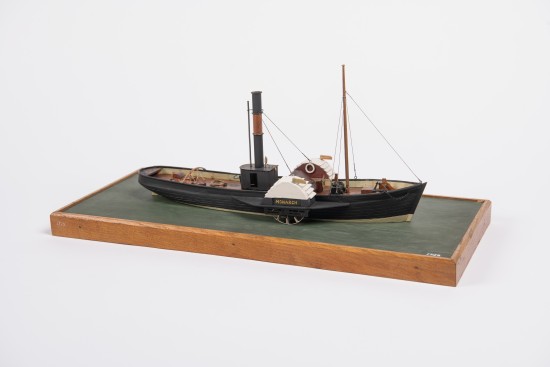
'Monarch' model
This model is a representation of a tug built on the Tyne in 1833. The Tyne-built tug boats hired to tow Temeraire, London and Samson, were larger and more powerful, but the model gives a useful idea of how they would have looked. If you compare the model to the tugboat in The Fighting Temeraire, you can see how Turner employed artistic licence by placing his tugboat’s funnel in an impossible position.
This model was probably only made due to the mythology that surrounds The Fighting Temeraire. There is a persistent tradition that Monarch towed Temeraire on its final journey, but no contemporary evidence seems to support it.
Monarch model, made about 1933 (scale 1:48), wood, cordage and paint. Discovery Museum, Tyne & Wear Archives & Museums
Steamer and Lightship; a study for 'The Fighting Temeraire'
A note Turner made on the back of this painting suggests it is a ‘first sketch’ for The Fighting Temeraire. The ship itself is barely visible, the vessel on the right being the Nore lightship, which warned passing ships about a sandbank at the mouth of the Thames. Only the presence of the steam tug on the left makes it possible to imagine this canvas as a first idea for the finished painting.
Joseph Mallord William Turner (1775–1851)
Oil on canvas
H 91.4 x W 119.7 cm
Tate
Peace - Burial at Sea
Peace – Burial at Sea has much in common with The Fighting Temeraire. Both are examples of Turner’s late exhibited paintings; both subjects include a combination of steam and sail power; and both are imagined compositions displayed by the artist alongside texts explicitly linking them to real contemporary events. In the case of Peace, the event was the funeral of Turner’s friend and artistic contemporary, David Wilkie, on board the steamship Oriental. The intense black of the sails was criticised when Turner exhibited the painting. Fitting for a funeral, dramatic black is also seen elsewhere in the canvas, and perhaps echoes the coal fuelling the steamship.
Joseph Mallord William Turner (1775–1851)
Oil on canvas
H 87 x W 86.7 cm
Tate
The Thames above Waterloo Bridge
In this unfinished canvas, Turner evoked the smoky atmosphere and murkiness of the Thames during the 1830s. The river was polluted with sewage and the spoils of industry. One of Turner’s contemporaries, the northeast-born artist John Martin (also an important figure within the Laing’s collection) proposed a plan to divert sewage from the Thames. This never came to fruition, but Turner served on a commission investigating the scheme, so must also have taken an interest in the poor state of the river.
Joseph Mallord William Turner (1775–1851)
Oil on canvas
H 90.5 x W 121 cm
Tate
1835
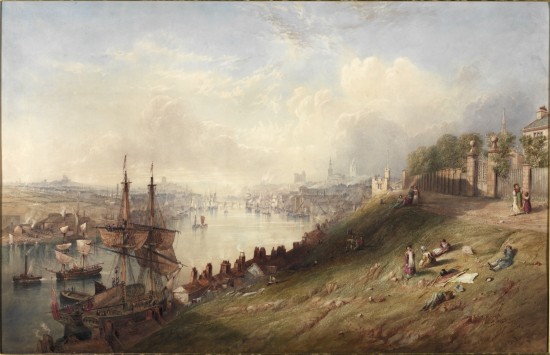
Newcastle from St Anne's
Carmichael, a celebrated Newcastle marine artist, shared Turner’s interest in capturing the industrial aspects of the region’s landscape. This grand and sweeping view of the Tyne from the Newcastle side includes a steam paddle tug – considerably smaller than the ones hired to tow the Temeraire a few years later - towing a brig towards the mouth of the Tyne. A group of sailors is rigging the ship by the riverbank. The figures in the foreground enjoy some leisure time as the busy river stretches out before them, the city’s historic landmarks visible in the distance.
John Wilson Carmichael (1799-1868), Newcastle from St Anne's, 1835, pencil, watercolour and bodycolour on paper with scratching out
Rise, Fall & Future
Other artists have followed Turner's example in some way when exploring the industrial and post-industrial landscape. The works displayed in the final section of the exhibition range from Victorian depictions of fast-paced technological development to works made only last year exploring the visual impact of new energy projects in Tyneside.
In Britain, heavy industry expanded hugely during Turner’s lifetime and beyond before experiencing steep decline in the twentieth century. The impact of this is felt to this day, as is the contribution these same industries made to the current climate crisis and the need for new forms of energy production.
Lowry is celebrated for his industrial subjects. The setting of this scene is not known, though it is possible that it is inspired by the northeast, as Lowry passed through the area regularly in the 1930s on his way to visit Berwick-upon-Tweed. The distinctive form of a winding-gear for coal can be seen on the right. Like Turner, Lowry seems to revel in the depiction of dark smoke and the industry of the river. Both artists employed a significant degree of imagination when recreating the industrial landscapes they had experienced.
Laurence Stephen Lowry (1887–1976)
Oil on board
H 37.5 x W 51.4 cm
Laing Art Gallery
Landscape in a Mining Area
Prunella Clough was interested in forgotten aspects of the urban landscape. Her subjects include spoil heaps and abandoned pits. This painting of a mining landscape feels forlorn and shadowy, the texture of the paint surface signalling the rockiness of the scene. She has said of her work: ‘the kind of landscape I am dealing with… demands something tougher and more brutal in terms of pictorial response.’
Prunella Clough (1919–1999)
Oil on canvas
H 57.6 x W 77.8 cm
Sheffield Museums
.
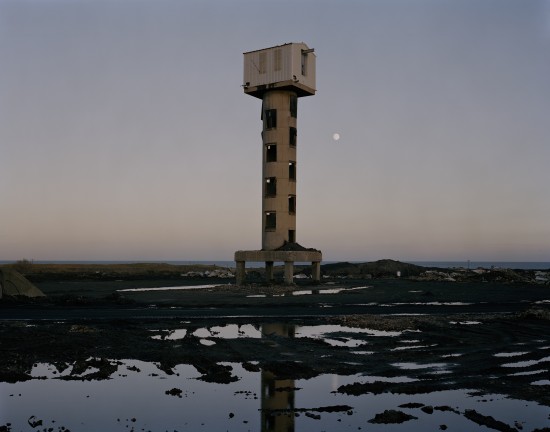
Monument
Monument depicts an abandoned coal distribution tower on the Northumberland coast. Kippin has noted that coalmining was, ‘basically an unsafe industry,’ in which, ‘many, many people lost their lives or were injured.’ He goes on to say: ‘But it’s also viewed nostalgically… it’s something which, understandably, communities were built around.’
John Kippin (born 1950), Monument, 2010/12, inkjet pigment print on paper, lent by the artist
